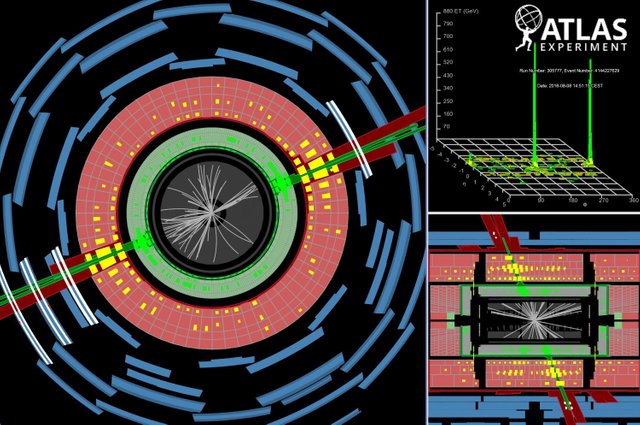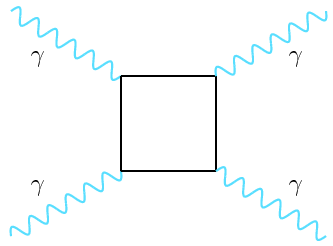Photon-photon scattering detected at LHC!
Photons form the basis of light - packets of energy that travel at 299 792 458 m/s. Yet, when two light beams usually shine across each other, nothing interesting happens. Since photons have no electric charge, Quantum Electrodynamics (QED) predicts that there should be no direct photon-photon interactions.

Photo Credit: CERN/ATLAS Team
However, photons can fluctuate into fermion-antifermion pairs (such as electron-positron pairs) which are charged and thus interact through higher-order corrections.

Photo Credit: Wikipedia
A photon can temporarily disintegrate into a virtual electron and positron, before recombining back to form the photon. During this period, the 2 pairs of electrons and positrons from the 2 photons can bounce of each other, producing a scattering effect. This is only observed with photons of high energy. These photons are produced by smashing lead nuclei of together at near light speed and observing the resultant decay. When 2 energetic photons are lucky enough to be close to one another, these photon-photon interactions can possibly be observed.

Photo Credit: Mariola et al. (2016)
These observations form a further confirmation of the Perturbative Quantum Electrodynamics, and allow us to probe deeper into photon structure.
References
- Klusek-Gawenda, M., Lebiedowicz, P., & Szczurek, A. (2016). Light-by-light scattering in UPC at the LHC. arXiv preprint arXiv:1606.09038.
- Fichet, S., von Gersdorff, G., Lenzi, B., Royon, C., & Saimpert, M. (2015). Light-by-light scattering with intact protons at the LHC: from Standard Model to New Physics. Journal of High Energy Physics, 2015(2), 165.
- ATLAS Collaboration. (2017). Evidence for light-by-light scattering in heavy-ion collisions with the ATLAS detector at the LHC. arXiv preprint arXiv:1702.01625.
- Salgado, C. A., Alvarez-Muniz, J., Arleo, F., Armesto, N., Botje, M., Cacciari, M., ... & Gelis, F. (2011). Proton–nucleus collisions at the LHC: scientific opportunities and requirements. Journal of Physics G: Nuclear and Particle Physics, 39(1), 015010.
Actually, the photon do not decay into the electron-positron pair as the latter two guys are virtual particles (and thus not observable). You must see this as a way to take care of the calculations and making predictions. The only think you observe in your detector are the final state particles.
Oops, thanks for the reminder. I think I phrased it badly there. The electron-positron pair are virtual off-shell particles and so exist only ephemerally.
Well, that's actually the point: they don't exist, even ephemerally.
Well, they exist in the sense that they are disturbances of the underlying field. I am not claiming that they can be observed anywhere. In perturbation theory, one still integrates over the virtual particles' momentum to get the amplitudes.
That's a calculation trick. You seem to say,. in your post, that they materalize, but they don't. That's my only point. You could for instance use other techniques going beyond the Feynman diagram approach for taking care of the same calculation and get the same result.
CERN has this amazing statue outside the premises... does anyone know what it's called??
It is called a gift from India as a reward for the CERN-India collaboration :)
but what does the statue represent?
The text on the plate is actually the explanation: 'Hundreds of years ago, Indian artists created visual images of dancing Shivas in a beautiful series of bronzes. In our time, physicists have used the most advanced technology to portray the patterns of the cosmic dance. The metaphor of the cosmic dance thus unifies ancient mythology, religious art and modern physics.'
More information can be found on the CERN website:
WOW...U R SO KNOWLEDGEABLE
Thanks :)
Congratulations @frostfractal! You have completed some achievement on Steemit and have been rewarded with new badge(s) :
Click on any badge to view your own Board of Honor on SteemitBoard.
For more information about SteemitBoard, click here
If you no longer want to receive notifications, reply to this comment with the word
STOPCongratulations @frostfractal! You have completed some achievement on Steemit and have been rewarded with new badge(s) :
Click on any badge to view your own Board of Honor on SteemitBoard.
For more information about SteemitBoard, click here
If you no longer want to receive notifications, reply to this comment with the word
STOP